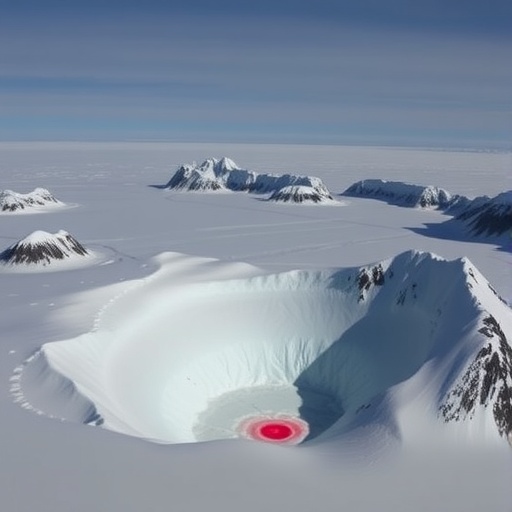A groundbreaking study has revealed significant insights into subglacial explosive volcanism in Antarctica, particularly focusing on the Ross Sea region. This research, conducted by an international team of scientists, uncovers the dynamics and implications of explosive volcanic activity that occurs beneath the thick ice sheets of this remote part of the world. Their study sheds light on how such phenomena might influence both local and global environments, including the precious ecological networks existing in the polar regions.
The Ross Sea, one of the most pristine marine environments in the world, has been largely shielded from human interference. However, the natural activities beneath its icy surface have long been a subject of intrigue among geologists and climate scientists. The research team utilized an innovative combination of satellite imagery, seismic monitoring, and ice-penetrating radar to investigate historical volcanic eruptions and their aftermath on glacial dynamics. This multi-faceted approach allowed for a more comprehensive understanding of the subglacial environment and its susceptibility to explosive events.
One of the most astonishing discoveries from the research involves the extent of volcanic systems hidden underneath the ice. The study indicates that not only are there active volcanic systems, but their interaction with melting ice plays a crucial role in altering ice flow dynamics and landscape morphology. This melting, exacerbated by volcanic heat, could potentially accelerate the calving of glaciers and modify the coastline, contributing to sea level rise—an urgent concern for coastal communities worldwide.
The implications of subglacial volcanism extend beyond immediate geological changes. The gases and ash emitted during explosive events can have far-reaching effects, not just regionally but globally. For instance, volcanic eruptions are known to inject particulate matter and sulfur dioxide into the atmosphere, affecting air quality and climate patterns. This is particularly significant in our current climate crisis, where understanding all variables impacting global warming is critical.
Furthermore, the research highlights the ecological repercussions of subglacial volcanism. Various microorganisms inhabit the subglacial ecosystems, perhaps thriving in volcanic nutrient-rich environments. The potential upwelling of nutrients from beneath the ice due to volcanic action could support diverse microbial communities, impacting entire food chains within the Antarctic ecosystem. The findings suggest that such interactions between geology and biology merit further exploration, particularly as they relate to resilience in the face of climate change.
The research team’s methodical approach included the extraction of sediment cores from the seafloor. These cores contained vital clues about past volcanic eruptions and subsequent changes in the ice sheet. Studying these sedimentary archives not only helped to trace the history of volcanic activity, but also revealed evidence of past climate conditions, offering a glimpse into how these systems have evolved over millennia.
Additionally, the researchers employed a network of seismic sensors to map the vibrations generated by volcanic activities. This seismic data provided real-time indicators of volcanic unrest, enabling the scientists to correlate seismic events with melting ice and potential caldera formation. The implications of this ongoing research could lead to improved monitoring of volatile volcanic environments, which is essential for predicting future eruptions and mitigating related hazards.
The findings of this research are not just academically enriching but also crucial for policymakers and environmental planners. Understanding the relationship between subglacial volcanism and climate change could reshape strategies for climate adaptation and mitigation. As global temperatures continue to rise, the impact of such explosive volcanic activity could become a more prominent factor in future climate scenarios.
The researchers also emphasize the importance of international collaboration in studying polar regions. Given the remote and challenging nature of the Antarctic environment, shared resources, expertise, and data are vital for advancing our understanding of these complex systems. This study exemplifies the collaborative spirit necessary to tackle pressing global challenges, including climate change and its myriad effects.
As they publish their findings, the authors pose critical questions for the future. How will the ongoing exploration of subglacial processes reshape our understanding of the Earth’s geology and climate history? What lessons can we learn from Antarctica’s past to address contemporary environmental challenges? Their inquiry invites further study, pushing the boundaries of current geological and environmental science.
Moreover, the research raises awareness about the broader implications at stake. As melting ice unveils these hidden volcanic systems, it serves as a reminder of the interconnectedness of Earth’s systems. Volcanoes can no longer be viewed solely as terrestrial hazards; instead, they must be understood within the context of oceanic, atmospheric, and ecological interactions.
In conclusion, the ground-breaking insights into subglacial explosive volcanism in Antarctica’s Ross Sea underline the importance of continued research in understanding our planet’s climate system. As scientists delve deeper into this nuanced interplay of geology and climate, the implications extend well beyond the icy confines of the Antarctic—touching on global climate dynamics, ecosystem integrity, and our ever-evolving relationship with Earth.
Subject of Research: Subglacial explosive volcanism in Antarctica
Article Title: Subglacial explosive volcanism in the Ross Sea of Antarctica
Article References:
Tominaga, M., Panter, K., Berthod, C. et al. Subglacial explosive volcanism in the Ross Sea of Antarctica.
Commun Earth Environ 6, 921 (2025). https://doi.org/10.1038/s43247-025-02878-x
Image Credits: AI Generated
DOI: https://doi.org/10.1038/s43247-025-02878-x
Keywords: Subglacial volcanism, Antarctic ice, climate change, oceanography, geological dynamics




